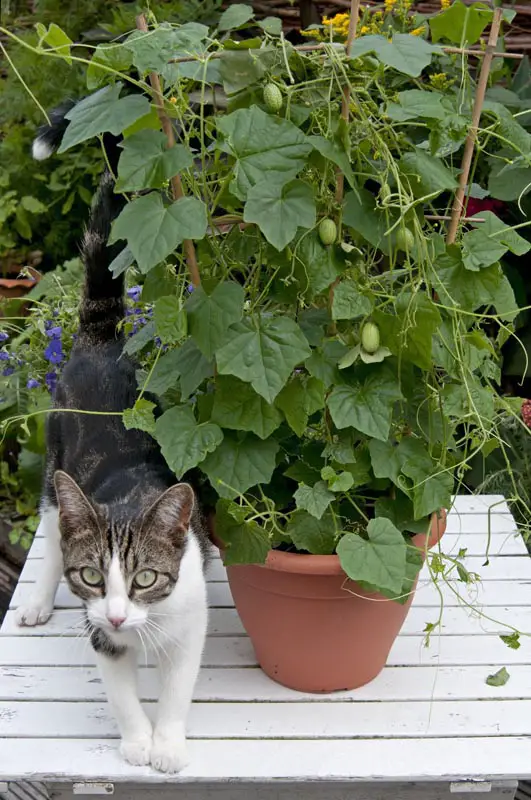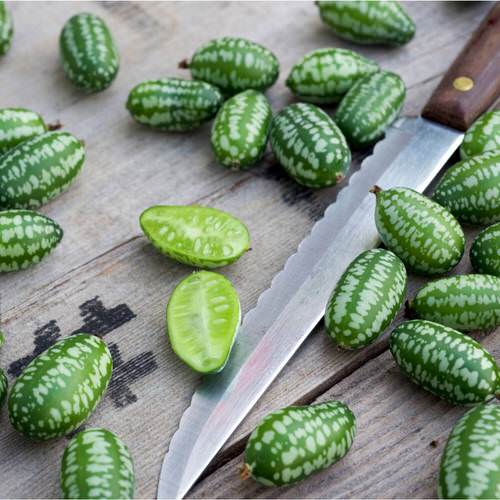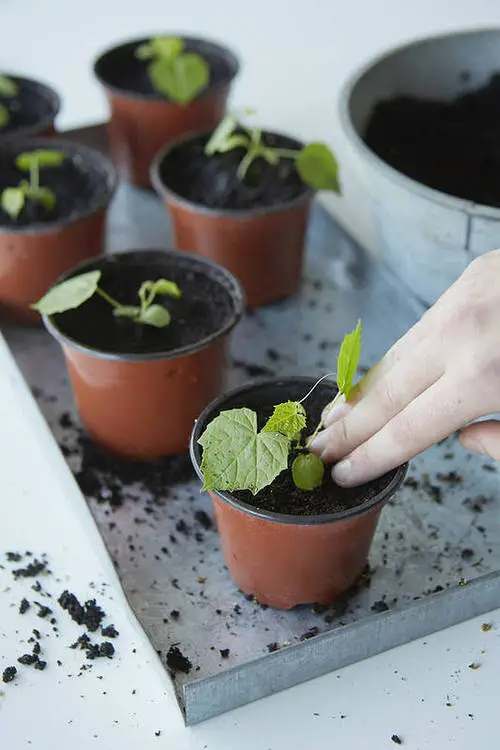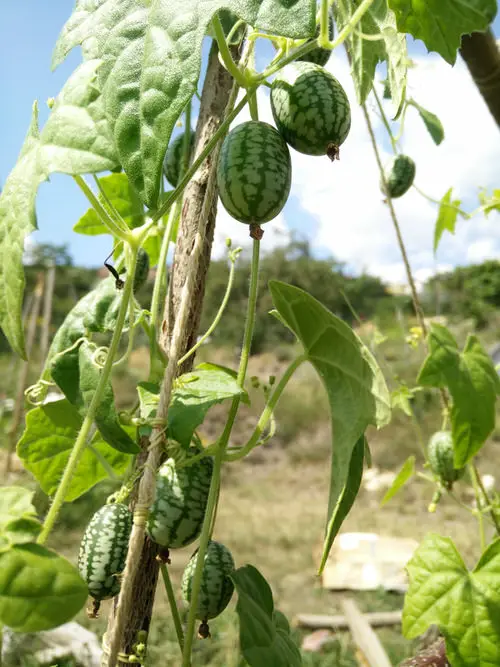Learn everything about How to Grow Cucamelon and relish this sweet little fruit that looks a lot like watermelon in your container garden!

A sweet little fruit that looks like small watermelons but in size is similar to grapes, with a flavor of cucumber dipped in lime! Let’s learn How to Grow Cucamelon and relish its exotic taste!
Botanical Name: Melothria scabra
Other Names: Mouse melon, Mexican sour gherkin, Mexican miniature watermelon, Mexican sour cucumber, and Pepquinos.
USDA Zones: 8-11
Check out our article on growing Kiwano Melons here!
Propagating Cucamelons

As cucamelon plants are not very popular, finding their seeds at a local store or nursery may be difficult. If you do, however, seedlings are preferable to seed. Another way to get your hands on the seeds is online.
When the ripe fruit falls from the plant, keep it in a cool place. After two weeks, slice the fruit in half and collect the seeds. Keep these seeds in a jar filled with water for about a week. After that, dry them on a paper towel; that’s it! Your seeds are ready to use.
Note: It is always a good idea to sow seeds directly in the desired location or in 4 inches separate pots.
Want to know how to grow watermelons in containers? Click here!
Growing Cucamelons in Pots

You can grow one or two plants in a 5 to 7-gallon pot (12-14 inches container). A 24 inches pot is good for growing 3-4 cucamelon vines. Make sure that the container has sufficient drainage holes. Amend the soil with plenty of organic matter.
Tip: If you are growing multiple plants, keep the containers 1-2 feet apart and provide support.
Requirements for Growing Cucamelons

Location
Cucamelons thrive in warmer conditions. You should plant them where they get at least 6 hours of sunlight daily. Planting them in the shade will result in lesser fruits.
Soil
Just like all fruiting plants, cucamelons also need nutrient-rich soil with good drainage. You can use organic matter and compost. For more details, check out our article on making DIY potting mix here.
Watering
Even in hot climatic conditions, cucamelons do not require watering daily, thanks to their water-storing ability in their roots in the form of tubers. In warm weather, you can water the plant once a week.
During cold days or when fog and clouds obstruct the sun for a prolonged period, water the plants only when the topsoil becomes dry.
Note: Overwatering can cause decaying of the roots, so avoid it.
Climatic Conditions
Cucamelon prefers warm growing conditions, but this does not mean that you can’t grow them in colder climates. Plant them after all the dangers of frost have passed.
Check out our article on growing Bitter Melon here!
Cucamelon Care

Use a Trellis or Wire Cage
Cucamelons can grow up to 7-10 feet in length and need a stable and robust structure to thrive. You can install a trellis or wire in the form of a mesh or cage.
This will not only act as a support structure but will also help you grow plants in any way you desire. Furthermore, the trellis is also going to help you in keeping the stem and fruits off the ground.
Fertilizer
The best time to fertilize the plant is when the flowers start to appear. Using fish emulsion in small amounts, once a week, is a good start. This is going to make sure the cucamelon production remains prolific. Alternatively, you can also use bonemeal.
Tip: Avoid using high nitrogen fertilizers as they might hamper the fruit production of the plant.
Pest and Diseases
Surprisingly, cucamelons are not prone to pests and diseases. As long as they’re off the ground. They do not require pest control measures. Yes! You heard it right! Due to some unknown reasons, pests leave cucamelons alone, and even birds steer clear of them!
Note: The plant is not susceptible to pests. However, it can be affected by root-knot nematodes.
Want to grow cucumbers in a small space? Click here!
Harvesting Cucamelons

Fruits start to appear just after 2 to 3 weeks of flowering. Pick them when they’re nice and firm, about one to one and a half-inch in length.
Harvesting cucamelons is no different than picking cucumbers. They are also very easy to store, thanks to their size! As long as you are going to keep them at room temperature, they’re going to do just fine.
However, over time, they’ll lose their crunchiness. Harvest some fruits a little earlier than their fruiting time, as it increases the production. Here are some of the ways you can use cucamelons:
- You can eat them fresh. You don’t even have to peel them off!
- Cucamelon pickle can be used in sandwiches and wraps.
- They can be used to garnish cocktails or lemonades.
- You can also add them to salads to have a citrusy and crunchy flavor!



My cucamelons make fruit then they fall off. What is causing that ? They are watered properly and fertilized. Is that normal for the first fruit to fall off or not ?
Hello, I live in zone 10b and my potted cucamelon plant receives about 5 hours of direct sunlight. However, we have been having 100+ degree days. Even though I water it, each day I walk out to find a significant portion of the plant’s leaves have completely dried up. Would it be fine if I move it to a location that is more shady? Or does it really need the direct sunlight?